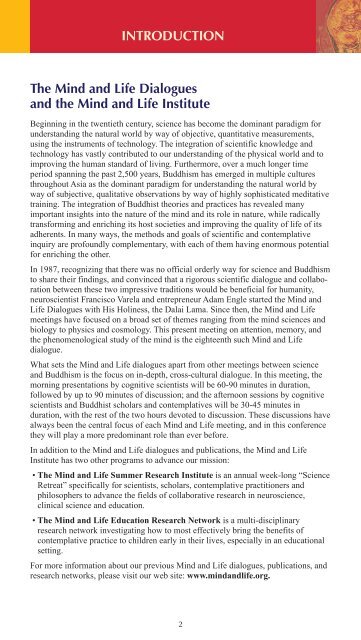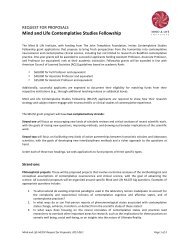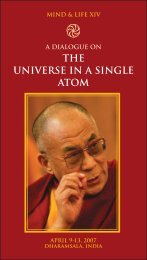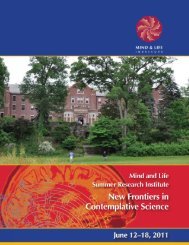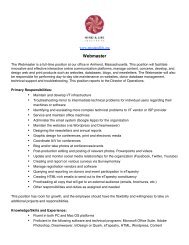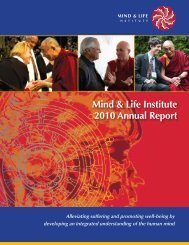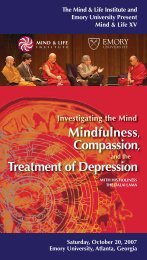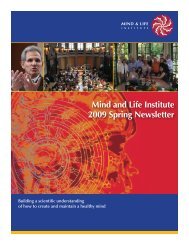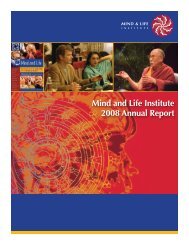to view the brochure from the conference (PDF). - Mind & Life Institute
to view the brochure from the conference (PDF). - Mind & Life Institute
to view the brochure from the conference (PDF). - Mind & Life Institute
Create successful ePaper yourself
Turn your PDF publications into a flip-book with our unique Google optimized e-Paper software.
INTRODUCTION<br />
The <strong>Mind</strong> and <strong>Life</strong> Dialogues<br />
and <strong>the</strong> <strong>Mind</strong> and <strong>Life</strong> <strong>Institute</strong><br />
Beginning in <strong>the</strong> twentieth century, science has become <strong>the</strong> dominant paradigm for<br />
understanding <strong>the</strong> natural world by way of objective, quantitative measurements,<br />
using <strong>the</strong> instruments of technology. The integration of scientific knowledge and<br />
technology has vastly contributed <strong>to</strong> our understanding of <strong>the</strong> physical world and <strong>to</strong><br />
improving <strong>the</strong> human standard of living. Fur<strong>the</strong>rmore, over a much longer time<br />
period spanning <strong>the</strong> past 2,500 years, Buddhism has emerged in multiple cultures<br />
throughout Asia as <strong>the</strong> dominant paradigm for understanding <strong>the</strong> natural world by<br />
way of subjective, qualitative observations by way of highly sophisticated meditative<br />
training. The integration of Buddhist <strong>the</strong>ories and practices has revealed many<br />
important insights in<strong>to</strong> <strong>the</strong> nature of <strong>the</strong> mind and its role in nature, while radically<br />
transforming and enriching its host societies and improving <strong>the</strong> quality of life of its<br />
adherents. In many ways, <strong>the</strong> methods and goals of scientific and contemplative<br />
inquiry are profoundly complementary, with each of <strong>the</strong>m having enormous potential<br />
for enriching <strong>the</strong> o<strong>the</strong>r.<br />
In 1987, recognizing that <strong>the</strong>re was no official orderly way for science and Buddhism<br />
<strong>to</strong> share <strong>the</strong>ir findings, and convinced that a rigorous scientific dialogue and collaboration<br />
between <strong>the</strong>se two impressive traditions would be beneficial for humanity,<br />
neuroscientist Francisco Varela and entrepreneur Adam Engle started <strong>the</strong> <strong>Mind</strong> and<br />
<strong>Life</strong> Dialogues with His Holiness, <strong>the</strong> Dalai Lama. Since <strong>the</strong>n, <strong>the</strong> <strong>Mind</strong> and <strong>Life</strong><br />
meetings have focused on a broad set of <strong>the</strong>mes ranging <strong>from</strong> <strong>the</strong> mind sciences and<br />
biology <strong>to</strong> physics and cosmology. This present meeting on attention, memory, and<br />
<strong>the</strong> phenomenological study of <strong>the</strong> mind is <strong>the</strong> eighteenth such <strong>Mind</strong> and <strong>Life</strong><br />
dialogue.<br />
What sets <strong>the</strong> <strong>Mind</strong> and <strong>Life</strong> dialogues apart <strong>from</strong> o<strong>the</strong>r meetings between science<br />
and Buddhism is <strong>the</strong> focus on in-depth, cross-cultural dialogue. In this meeting, <strong>the</strong><br />
morning presentations by cognitive scientists will be 60-90 minutes in duration,<br />
followed by up <strong>to</strong> 90 minutes of discussion; and <strong>the</strong> afternoon sessions by cognitive<br />
scientists and Buddhist scholars and contemplatives will be 30-45 minutes in<br />
duration, with <strong>the</strong> rest of <strong>the</strong> two hours devoted <strong>to</strong> discussion. These discussions have<br />
always been <strong>the</strong> central focus of each <strong>Mind</strong> and <strong>Life</strong> meeting, and in this <strong>conference</strong><br />
<strong>the</strong>y will play a more predominant role than ever before.<br />
In addition <strong>to</strong> <strong>the</strong> <strong>Mind</strong> and <strong>Life</strong> dialogues and publications, <strong>the</strong> <strong>Mind</strong> and <strong>Life</strong><br />
<strong>Institute</strong> has two o<strong>the</strong>r programs <strong>to</strong> advance our mission:<br />
• The <strong>Mind</strong> and <strong>Life</strong> Summer Research <strong>Institute</strong> is an annual week-long “Science<br />
Retreat” specifically for scientists, scholars, contemplative practitioners and<br />
philosophers <strong>to</strong> advance <strong>the</strong> fields of collaborative research in neuroscience,<br />
clinical science and education.<br />
• The <strong>Mind</strong> and <strong>Life</strong> Education Research Network is a multi-disciplinary<br />
research network investigating how <strong>to</strong> most effectively bring <strong>the</strong> benefits of<br />
contemplative practice <strong>to</strong> children early in <strong>the</strong>ir lives, especially in an educational<br />
setting.<br />
For more information about our previous <strong>Mind</strong> and <strong>Life</strong> dialogues, publications, and<br />
research networks, please visit our web site: www.mindandlife.org.<br />
2


